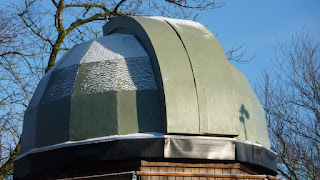*
Those who are into modding PSTs [and other solar
telescopes] should take a look at the Solar Chat Forum. Most modification ideas have
been tried there and discussed, proved or disproved of. Stargazers lounge has a strong group of Solar instrument builders, imagers and observers.
Avoid Cloudy Nights Forums. Talking about building or modding solar instruments is still a hanging offense over there in the Land of The Free.
I
was really struggling to focus the Neximage5 from my distant laptop. Now
somebody on Stargazers Lounge has suggested I use TeamViewer with my tablet and laptop. That way I can
have the tablet right beside the focuser while actively using the Neximage5.
Then
return to the heavy laptop on its pier-mounted shelf to carry out the capture stages. Today, I was able to see
the last dregs of sunshine hide behind cloud directly on my tablet screen. This was with
the Neximage5 right beside the camera in the focuser. Magical!
On returning to the
laptop, exactly the same image was showing in iCap. Racing cloud! This remote control idea has worked beyond all expectations! I am very pleased with this sudden leap in imaging progress. The tablet is not only light and handy, with a sharp image, but able to be turned at will to avoid bright reflections.
When not in use the tablet rests happily against the sloping pier beside the laptop. With its lower edge sitting firmly on the mouse mat. I could make a ledge for it to sit on the [sloping] north side of the pier. Just to be nearer the telescope. This would need a longer charging cable from the laptop. Which is permanently powered from its unbelievably massive power supply.
________________________________________
Today I managed to find a load of nesting, food storage boxes with snap-on lids on
offer in the local supermarket. So I was able to bring some order to my very mixed collection of star diagonals, extensions, binoviewer and pairs
of eyepieces. Conversion to the Light Side [Solar] meant an
extraordinary collection of bits and pieces to satisfy the exacting needs of the
H-alpha telescope.
The etalon and filters must satisfy their [original PST] positioning relative to the focal point of the bigger, donor telescope's objective. Arranging this with non-standard fittings and spacers is an expensive exercise! Fortunately I was initiated into the 2T thread size. For which a whole range of spacers, extenders, helical focusers, adapter and rings is readily available. At a price!
It may seem odd, to many, exactly how large my
instrumental set-up really is. When the telescopes are parked horizontally, on the south
side of the mounting, the weights are down. I simply cannot reach the objective lens covers without the help of
a beer crate. Even when the instruments are right down beside the mounting and
almost horizontal, I cannot see into the dewshields to check the objective lenses or filters.
At this time of year
the sun is very low indeed. Around 10 degrees maximum altitude! Which has required the beer crate, or paired off-cuts of 4x4,
just to reach the eyepieces. My eye level is not far short of 6' on tip toe. Beware of blind
ambition!
As the year progresses I shan't need the extra
risers as the telescopes are tilted far more. So I am loath to invest in any
more stepladders. Since these would soon become an absolute nuisance in the
limited space available in the observatory. I keep one extending stepladder in the
observatory for reaching high in the dome or to work on the mounting. It takes up serious acreage even when
folded flat and vertically against the observatory wall.
An octagon is considerably smaller than a circle of
the same radius. A square is very much larger. I would urge those
contemplating a design for a domed building to give these simple facts
considerable thought. Why a dome? Because it is traditional? You can
avoid the infinite complexity of constructing a plywood dome by building a rotating, half
cylinder. This has a nominally square base and can be parked [squarely] over a
matching square building.
More importantly the half cylinder [dome] has no 3D surfaces on which to try to crease and fold 2D metal or plywood gores. The corners of the half cylinder provide lots of headroom. The flat end walls offer room for storage or even windows. You need no fancy flashing to make the dome run-off fall outside the building and everything is in straight lines. The shutters lie flat on the half cylinder instead of catching the wind as mine do regularly. Doing so whether open or closed.
Sunday: Further improved security on the observatory. Then turned a 10mm thick, aluminium disk to fit inside the CR150 tailpiece. I plan to run adjusting rods forwards to the internal D-ERF to see if tilting helps and by how much of either. So I need a stable surface to thread for the adjusters. The D-ERF sits on an original CR150 baffle about half way down the main tube. I tried gently poking the baffle with a dowel but it's bit crude and risks scratching the D-ERF.
*









































